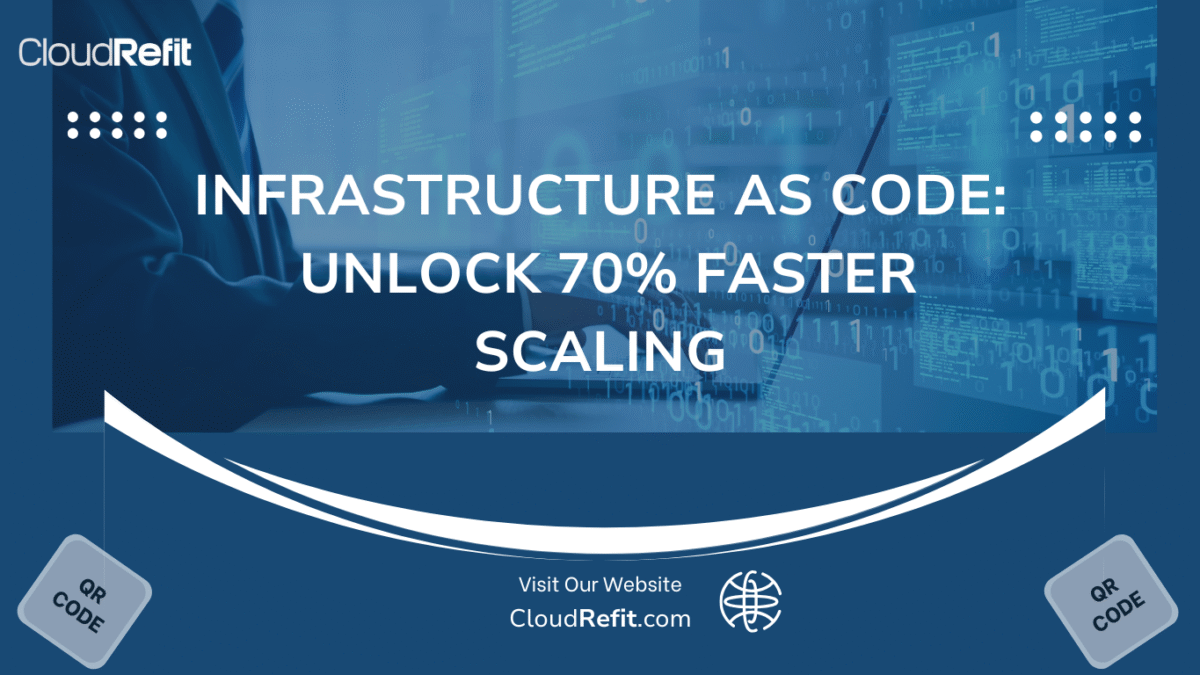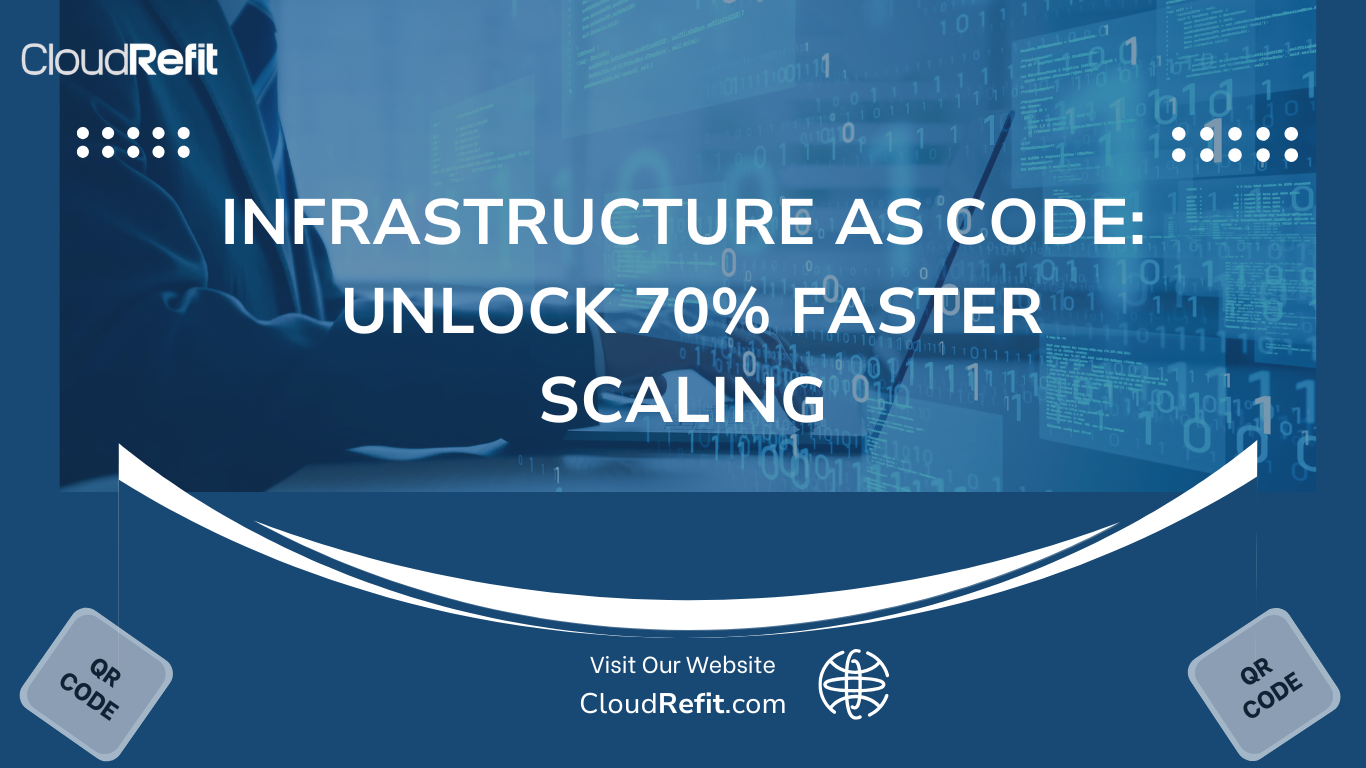Infrastructure as Code (IaC) is revolutionizing how businesses manage their IT infrastructure in today’s rapidly evolving digital landscape. As organizations face immense pressure to innovate, scale, and control costs, IaC provides a transformative solution. By automating the provisioning, configuration, and management of resources through code, IaC allows businesses to streamline operations, improve agility, and significantly reduce operational expenses. At CloudRefit, we leverage the power of IaC to help startups and SMEs optimize their cloud environments, drive digital transformation, and stay ahead in a competitive market.

This article explores the fundamentals of Infrastructure as Code, its core benefits, and how CloudRefit leverages IaC to streamline IT operations, enhance system stability, and ensure scalability in a dynamic market.
What is Infrastructure as Code and Why is it Revolutionary?
Infrastructure as Code (IaC) is a paradigm shift in IT management that allows organizations to manage and provision computing infrastructure through machine-readable definition files, rather than through physical hardware configuration or interactive configuration tools. With IaC, every aspect of your IT environment—from servers and networks to storage systems—can be described using code, enabling complete automation of setup, configuration, and management tasks.
Key Advantages of Infrastructure as Code include:
1. Automated Provisioning and Deployment:
Tools like Terraform, Ansible, and Puppet enable the automatic creation and configuration of infrastructure. This means that environments can be spun up or down quickly with minimal manual intervention, drastically reducing deployment times and the risk of human error.
2. Consistency Across Environments:
Since infrastructure is defined as code, the same configuration can be used across development, testing, and production environments. This uniformity minimizes discrepancies and “works on my machine” issues, ensuring that applications run reliably regardless of the environment.
3. Scalability and Flexibility:
IaC makes it easy to scale resources up or down based on demand. Automated scripts can adjust resource allocation in real time, ensuring optimal performance without over-provisioning. This dynamic scaling is particularly beneficial in cloud environments where workloads can vary significantly.
4. Cost Efficiency:
By automating infrastructure management, IaC reduces the need for manual labor and minimizes downtime. The pay-as-you-go model in cloud environments, combined with the efficient resource allocation enabled by IaC, leads to significant cost savings over traditional infrastructure management.
5. Improved Security and Compliance:
With Infrastructure as Code, security policies and compliance measures can be codified and applied consistently across all environments. Automated audits and updates help ensure that all configurations remain compliant with industry standards and regulatory requirements.
How CloudRefit Leverages Infrastructure as Code ?
At CloudRefit, IaC is a cornerstone of our digital transformation strategy. We integrate IaC into our service offerings to deliver robust, agile, and scalable cloud environments tailored to the unique needs of our clients. Here’s how we implement IaC:
1. Comprehensive Infrastructure Assessment:
We begin by conducting an in-depth analysis of the current IT environment to identify inefficiencies and underutilized resources. This assessment helps us determine which aspects of the infrastructure can be optimized and automated using Infrastructure as Code, laying the groundwork for a smoother transition to a code-driven management approach.
2. Automated Provisioning and Configuration:
Using tools such as Terraform and Ansible, CloudRefit automates the provisioning of servers, networks, and storage. This automation not only speeds up the setup process but also ensures that every component of the infrastructure is configured consistently, reducing the likelihood of errors and misconfigurations.
3. Unified Environment Management:
By defining infrastructure as code, we can replicate the exact same environment across development, testing, and production stages. This consistency is crucial for reducing compatibility issues and ensuring that applications perform reliably across all stages of deployment.
4. Integration with CI/CD Pipelines:
We integrate IaC into our continuous integration and continuous deployment (CI/CD) workflows using tools like Jenkins and GitLab CI/CD. This integration ensures that every code update triggers an automated update of the underlying infrastructure, enabling rapid iteration and reducing downtime.
5. Hybrid Cloud Solutions:
CloudRefit leverages Infrastructure as Code to design hybrid cloud solutions that blend public and private cloud resources. This approach allows mission-critical applications to reside in secure, on-premise environments while taking advantage of the scalability and cost benefits of public clouds for non-sensitive operations.
6. Enhanced Monitoring and Maintenance:
IaC enables us to implement robust monitoring and logging systems. With automated scripts in place, any deviation from the desired state is quickly identified and corrected. This proactive approach helps maintain system stability and ensures that infrastructure remains secure and compliant.
Case Study: Transforming Legacy Infrastructure with IaC
One of our SaaS startup clients was grappling with an outdated, manually managed infrastructure that led to frequent downtime, high operational costs, and an inability to scale effectively during peak demand. CloudRefit was tasked with transforming their legacy infrastructure using an IaC approach.
The Challenges
- Manual configuration processes were slow and error-prone.
- Inconsistent environments across development, testing, and production led to compatibility issues.
- High costs and inefficient resource usage hindered scalability.
Our Approach
- Initial Audit:
We conducted a comprehensive audit to assess the existing infrastructure, identifying critical areas where manual processes were causing delays and errors. - Migration to IaC:
Using Terraform and Ansible, we transitioned the client’s entire IT environment into code. This allowed for automated provisioning and consistent configuration across all environments. - CI/CD Integration:
We integrated IaC into the client’s CI/CD pipelines, ensuring that any change in code automatically triggered an update in the infrastructure. - Hybrid Model Deployment:
To address security and compliance requirements, we implemented a hybrid model where critical data was managed on-premise, and other services were migrated to the public cloud.
Results
- 70% Faster Provisioning:
Automated processes reduced the time required to deploy new environments from hours to minutes. - 40% Reduction in Operational Costs:
Optimized resource allocation and elimination of manual interventions led to significant cost savings. - Improved Consistency and Stability:
The unified environment ensured by IaC reduced compatibility issues and improved system reliability, resulting in fewer downtimes. - Scalable and Flexible Infrastructure:
The client’s infrastructure could now scale dynamically in response to changing workloads, ensuring optimal performance during peak periods.
Future Outlook for IaC with CloudRefit
As technology continues to advance, CloudRefit remains committed to enhancing its IaC solutions to further streamline IT operations and drive digital transformation. Future initiatives include:
1. AI-Driven Optimization:
We plan to integrate artificial intelligence and machine learning to analyze performance data and predict resource needs, allowing for even more efficient resource allocation.
2. Expanded Hybrid Solutions:
Our roadmap includes developing more advanced hybrid cloud models that provide seamless integration between on-premise and public cloud resources, offering enhanced security and flexibility.
3. Advanced Automation Tools:
Investing in next-generation automation tools will further reduce manual intervention and accelerate deployment cycles, ensuring rapid adaptation to market demands.
4. Enhanced Security and Compliance:
Ongoing development of robust security protocols and continuous monitoring tools will ensure that our IaC implementations meet the highest standards of data protection and regulatory compliance.
Conclusion
Infrastructure as Code is a game-changing approach that transforms how organizations manage their IT environments. By automating the provisioning and configuration of infrastructure, IaC not only reduces operational costs and minimizes errors but also enables rapid scaling and enhanced consistency across all environments. At CloudRefit, we leverage IaC to deliver a robust, agile, and secure IT infrastructure that empowers businesses to achieve digital transformation efficiently.
If you are ready to transform your IT environment and unlock the full potential of automation and scalability through Infrastructure as Code, CloudRefit is here to provide you with the expertise and cutting-edge solutions you need to succeed in the digital age.
📩 Have questions about implementing Infrastructure as Code in your IT environment? Contact CloudRefit today for a free consultation!
AmazonWeb Success: How CloudRefit Slashes Costs & Boosts Security by 40%

